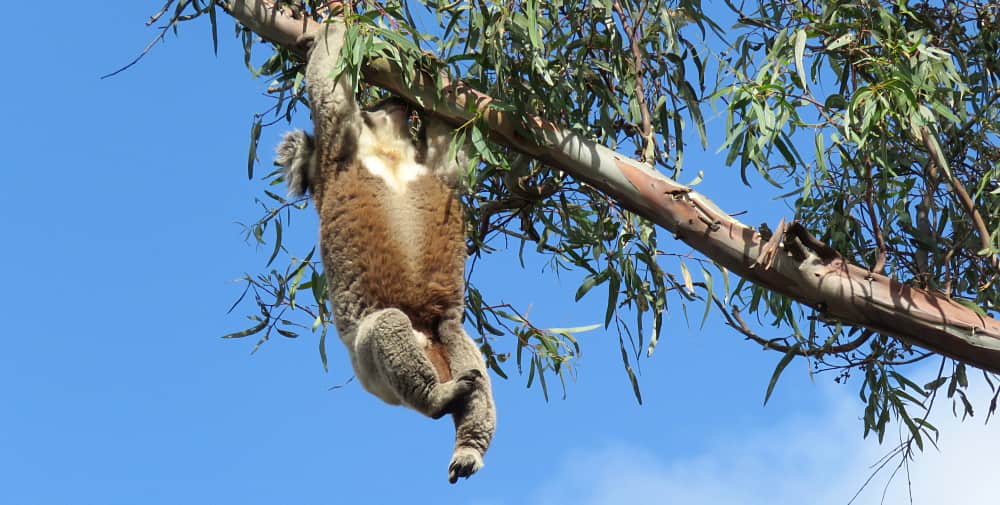A Koala Buffet
Information flowing from of our new friends in the Mornington Peninsula Koala Conservation Group, has challenged some of my long-held ideas on Koala habits (correctly so). Here we examine Koala’s all-important dietary and feeding preferences based on recent 24/7 observations by Marsh et al (2014a and 2014b) at the Philip Island Sanctuary.
Counter to earlier research assumptions, they found that Koalas mostly feed at night. Koalas also utilise different types of tree for resting and feeding. Resting trees were visited primarily in the daytime, are higher and are often different species compared to feeding trees, where Koalas spend much of their night.

Of the total of 112 Eucalypts that were visited:
- 62 were only visited at night (arrive after dark and leave before dawn)
- 21 were only visited during the day
- 29 were visited during both day and night
- 24 were visited by two or more Koalas (at different times).
Distances travelled between trees varied from 1-200 m and the total distance travelled in 24 h varied from 0-450 m.
The variety and preferences for trees visited is provided in Table. 1 – note that Koalas in other areas may consume different species to those listed here.

Table 1: Visits to different tree and bush species within the sanctuary. The time occupied is the time koalas spent in each species as a percentage of the total time koalas spent in trees (2669 h). Feeding visits are the number of visits during which koalas fed for at least 1 min. Time feeding indicates the percentage for each species of the total feeding time (302 h)
Manna Gums (E. viminalis) were the clear favourite, followed by Southern Blue Gums (E. globulus, not found on the Peninsula), Swamp Gums (E. ovata), and surprisingly, Bursaria spinosa.
The results also agree with other more-comprehensive assessments across a range of regularly-monitored Koala populations (see, e.g., Koala’s Restaurant). However, there is evidence of considerable variability in population preferences – for example, some populations feed mainly on Messmates (E. obliqua).
Blyton et al (2019) provide potential explanations for these differences based on the Koala gut biomes (bacteria used for digestion). They used inoculations of poo from a group that preferred Messmates into another that preferred Manna Gums and showed that given the right selections of biomes, the Koalas could be induced to change dietary preferences.
Studies such as these provide important information for our selection of habitat and plant types for planting in support of Koalas in our region – both in the preferred types of trees and in the desired and acceptable separation between these trees
It is important that we do not replace local vegetation with, for example, Manna Gums in areas where they are alien to the local vegetation types. Happily, Manna gums are present in a wide variety of Ecological Vegetation Classes (EVCs) across the Peninsula, including: Damp Sands Herb-rich Woodland (EVC 03, common across the southern Peninsula and Greens Bush), and Herb-rich Foothills Forest (EVC 23, widespread across the whole Peninsula).
Care also is needed to plant species such as Manna gum at a density similar to what is observed in natural settings. For example, Manna Gumsr are occur in dense groupings so planting them densely in sole-species groupings can be counter productive. Here we are helped by the large distances that Koalas such as those at Phillip Island travel between nightly feeds (typically 30-50 m and up to 200 m)
The golden rule is to check before you choose and plant. SPIFFA provides an excellent overview of what is meant by EVC, together with a catalogue of species in Peninsula EVCs.
On The Mornington Peninsula we know that Coastal Manna Gum (E. viminalis ssp pryoriana), Swamp Gum (E. ovata), and Narrow-leaved Peppermint (E. radiata ssp radiata) are key food trees for koalas and are applicable to a wide variety of EVCs. Please get in touch with either myself of and Dirk Janson if you would like to create koala habitat on your property.
– Article by Greg Holland, Image from here.